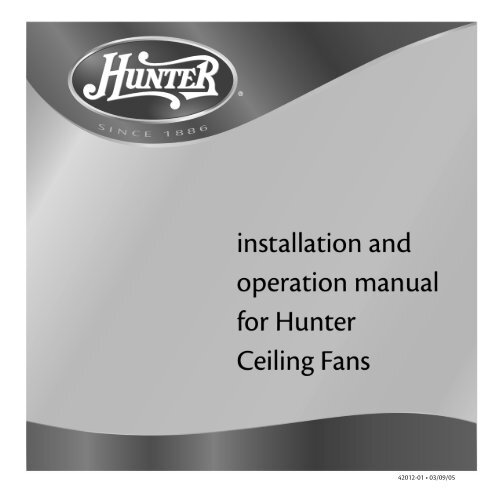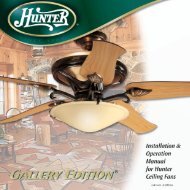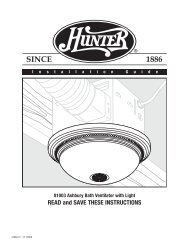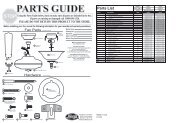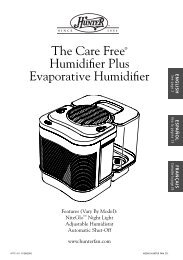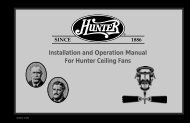42012-01 • 03/09/05 - Hunter Fan Company
42012-01 • 03/09/05 - Hunter Fan Company
42012-01 • 03/09/05 - Hunter Fan Company
Create successful ePaper yourself
Turn your PDF publications into a flip-book with our unique Google optimized e-Paper software.
<strong>42<strong>01</strong>2</strong>-<strong>01</strong> <strong>•</strong> <strong>03</strong>/<strong>09</strong>/<strong>05</strong>
2<br />
Welcome<br />
For Your Records and Warranty<br />
Assistance<br />
Model Name: _____________________<br />
Catalog/Model No.: ________________<br />
Serial No.: _______________________<br />
Date Purchased: ___________________<br />
Where Purchased: _________________<br />
For reference also attach your receipt or a<br />
copy of your receipt to the manual.<br />
Table of Contents<br />
1 <strong>•</strong> Getting Ready ...................................................4<br />
2 <strong>•</strong> Installing the Hanger Bracket...................5<br />
3 <strong>•</strong> Assembling and Hanging the <strong>Fan</strong>..........6<br />
4 <strong>•</strong> Wiring the <strong>Fan</strong>..................................................8<br />
5 <strong>•</strong> Installing the Canopy and<br />
Canopy Trim Ring............................................9<br />
6 <strong>•</strong> Assembling the Blades .............................. 10<br />
7 <strong>•</strong> Installing the Switch Housing................ 11<br />
8 <strong>•</strong> Installing the Light Fixture ...................... 12<br />
9 <strong>•</strong> Operating and Cleaning<br />
Your Ceiling <strong>Fan</strong> ............................................ 13<br />
10 <strong>•</strong> Troubleshooting......................................... 14<br />
Your new <strong>Hunter</strong>® ceiling fan is an addition to your home or office that<br />
will provide comfort and performance for many years. is installation<br />
and operation manual gives you complete instructions for installing<br />
and operating your fan.<br />
We are proud of our work. We appreciate the opportunity to supply<br />
you with the best ceiling fan available anywhere in the world.<br />
Before installing your fan, for your records and warranty assistance,<br />
record information from the carton and <strong>Hunter</strong> nameplate label<br />
(located on the top of the fan motor housing).<br />
Cautions and Warnings<br />
<strong>•</strong> Read this entire manual carefully before beginning installation. Save<br />
these instructions.<br />
<strong>•</strong> Use only <strong>Hunter</strong> replacement parts.<br />
<strong>•</strong> To reduce the risk of personal injury, attach the fan directly to the<br />
support structure of the building according to these instructions,<br />
and use only the hardware supplied.<br />
<strong>•</strong> To avoid possible electrical shock, before installing your fan,<br />
disconnect the power by turning off the circuit breakers to the<br />
outlet box and associated wall switch location. If you cannot lock<br />
the circuit breakers in the off position, securely fasten a prominent<br />
warning device, such as a tag, to the service panel.<br />
<strong>•</strong> All wiring must be in accordance with national and local electrical<br />
codes and ANSI/NFPA 70. If you are unfamiliar with wiring, use a<br />
qualified electrician.<br />
<strong>•</strong> To reduce the risk of personal injury, do not bend the blade<br />
attachment system when installing, balancing, or cleaning the fan.<br />
Never insert foreign objects between rotating fan blades.<br />
<strong>•</strong> To reduce the risk of fire, electrical shock, or motor damage, do not<br />
use a solid-state speed control with this fan. Use only <strong>Hunter</strong> speed<br />
controls.<br />
© 2004 <strong>Hunter</strong> <strong>Fan</strong> <strong>Company</strong><br />
<strong>Hunter</strong> <strong>Fan</strong> <strong>Company</strong> <strong>42<strong>01</strong>2</strong>-<strong>01</strong> <strong>•</strong> <strong>03</strong>/<strong>09</strong>/<strong>05</strong>
Installer’s Choice and Optional Accessories<br />
Understanding Mounting and Installer’s Choice®<br />
<strong>Hunter</strong>’s patented 3-position mounting system provides you maximum<br />
installation flexibility and ease. You can install your <strong>Hunter</strong> fan in one<br />
of three ways, depending on ceiling height and your preference: Low<br />
Profile, Standard, or Angle mounting. e steps in this manual include<br />
instructions for all three Installer’s Choice mounting methods.<br />
Considering Optional Accessories<br />
Consider using <strong>Hunter</strong>’s optional accessories, including a wall-mounted<br />
or remote speed control. To install and use the accessories, follow<br />
the instructions included with each product. For quiet and optimum<br />
performance of your <strong>Hunter</strong> fan, use only <strong>Hunter</strong> speed controls.<br />
Low Profile Mounting fits close to the<br />
ceiling, recommended for ceilings less<br />
than 8 feet high<br />
Standard Mounting hangs from<br />
the ceiling by a downrod (included),<br />
recommended for ceilings 8 feet or higher<br />
3<br />
For ceilings higher than 8 feet, you<br />
can purchase <strong>Hunter</strong> extension<br />
downrods. All <strong>Hunter</strong> fans use sturdy<br />
3/4” diameter pipe to assure stability<br />
and wobble-free performance.<br />
Angle Mounting recommended for a<br />
vaulted or angled ceiling<br />
<strong>42<strong>01</strong>2</strong>-<strong>01</strong> <strong>•</strong> <strong>03</strong>/<strong>09</strong>/<strong>05</strong> <strong>Hunter</strong> <strong>Fan</strong> <strong>Company</strong>
4<br />
1 <strong>•</strong> Getting Ready<br />
Installing Multiple <strong>Fan</strong>s<br />
If you are installing more than<br />
one fan, keep the fan blades in<br />
sets, as they were shipped.<br />
To install a ceiling fan, be sure you can do the following:<br />
<strong>•</strong> Locate the ceiling joist or other suitable support in ceiling.<br />
<strong>•</strong> Drill holes for and install wood screws.<br />
<strong>•</strong> Identify and connect electrical wires.<br />
<strong>•</strong> Lift 40 pounds.<br />
If you need help installing the fan, your <strong>Hunter</strong> fan dealer can direct<br />
you to a licensed installer or electrician.<br />
Gathering the Tools<br />
You will need the following tools for installing the fan:<br />
<strong>•</strong> Electric drill with 9/64” bit<br />
<strong>•</strong> Standard screwdriver<br />
<strong>•</strong> Phillips-head screwdriver<br />
<strong>•</strong> Wrench or pliers<br />
Checking Your <strong>Fan</strong> Parts<br />
Carefully unpack your fan to avoid damage to the fan parts. Check<br />
for any shipping damage to the motor or fan blades. If one of the fan<br />
blades was damaged in shipment, return all the blades for replacement.<br />
If any parts are missing or damaged, contact your <strong>Hunter</strong> dealer or call<br />
<strong>Hunter</strong> Parts Department at 888-830-1326.<br />
Preparing the <strong>Fan</strong> Site<br />
Before you begin installing the fan, follow all the instructions in<br />
the pullout sheet called “Preparing the <strong>Fan</strong> Site.” Proper ceiling fan<br />
location and attachment to the building structure are essential for<br />
safety, reliable operation, maximum efficiency, and energy savings.<br />
<strong>Hunter</strong> <strong>Fan</strong> <strong>Company</strong> <strong>42<strong>01</strong>2</strong>-<strong>01</strong> <strong>•</strong> <strong>03</strong>/<strong>09</strong>/<strong>05</strong>
2-1. Drill two pilot holes into the wood support structure through the<br />
outermost holes in the outlet box. e pilot holes should be 9/64”<br />
in diameter.<br />
Note: Your fan comes with four pre-installed neoprene noise<br />
isolators.<br />
2-2. read the lead wires from the outlet box down through the hole<br />
in the middle of the hanger bracket.<br />
2-3. Align the slotted holes in the hanger bracket with the pilot holes<br />
you drilled in the wood support structure. For proper alignment<br />
use slotted holes directly across from each other. If you are<br />
installing the fan on an angled ceiling, be sure to orient the hanger<br />
bracket with the large opening towards the ceiling peak.<br />
Note: e isolators should be flush against the ceiling.<br />
2-4. Place a flat washer on each of the two 3” screws and pass the<br />
screws through the slotted holes in the hanger bracket into the<br />
pilot holes you drilled.<br />
Tighten the screws into the 9/64” pilot holes; do not use lubricants<br />
on the screws. Do not over tighten.<br />
2 <strong>•</strong> Installing the Hanger Bracket<br />
Isolator<br />
Hanger<br />
Bracket<br />
5<br />
Flat Washer<br />
Steps 2-2 – 2-4<br />
Step 2-3 (Angled Ceiling Only)<br />
3” Screw<br />
For Angled Ceilings: Be sure to orient<br />
the hanger bracket with the large<br />
opening towards the ceiling peak.<br />
<strong>42<strong>01</strong>2</strong>-<strong>01</strong> <strong>•</strong> <strong>03</strong>/<strong>09</strong>/<strong>05</strong> <strong>Hunter</strong> <strong>Fan</strong> <strong>Company</strong>
3 <strong>•</strong> Assembling and Hanging the <strong>Fan</strong><br />
Standard<br />
Mounting<br />
Washer<br />
Label<br />
You can assemble your fan for standard or angle mounting as shown<br />
in steps 3-1 – 3-6. For low profile mounting (ceilings less than 8 feet<br />
high), go to steps 3-7 – 3-11 on the next page.<br />
6<br />
Step 3-1<br />
Steps 3-2 – 3-4<br />
Adapter<br />
Downrod<br />
Canopy<br />
Canopy<br />
(with Washer)<br />
Canopy<br />
Trim Ring<br />
Set Screw<br />
3-1. Remove the label from the standard mounting washer inside the<br />
canopy. Leave the washer in place. (Note: You will not use the<br />
washer included in the parts sack.)<br />
3-2. To assemble fan to hang down from a flat or angled ceiling, place<br />
the canopy with washer, and canopy trim ring around the adapter<br />
so that they rest on the fan assembly.<br />
3-3. Feed the wires from the fan through the downrod.<br />
3-4. Screw the downrod into the fan assembly. Tighten the square<br />
head set screw.<br />
CAUTION: e downrod has a special coating on the threads.<br />
Do not remove this coating; the coating prevents the downrod from<br />
unscrewing. Once assembled, do not remove the downrod.<br />
WARNING: Do not carry or lift fan by canopy.<br />
3-5. Raise the fan and place the ball into the hanger bracket.<br />
3-6. Align the notch on the ball with the indent in the hanger bracket.<br />
(Rotate the fan until you hear the notch pop into place.)<br />
Go to 4 <strong>•</strong> Wiring the <strong>Fan</strong>.<br />
WARNING: <strong>Fan</strong> may fall if not assembled as directed in these<br />
installation instructions.<br />
Indent<br />
Steps 3-5 – 3-6<br />
<strong>Hunter</strong> <strong>Fan</strong> <strong>Company</strong> <strong>42<strong>01</strong>2</strong>-<strong>01</strong> <strong>•</strong> <strong>03</strong>/<strong>09</strong>/<strong>05</strong>
3 <strong>•</strong> Assembling and Hanging the <strong>Fan</strong> (Low Profile Only)<br />
You can assemble your fan for standard or angle mounting as shown<br />
in steps 3-1 – 3-6 on the previous page. For low profile mounting<br />
(ceilings less than 8 feet high), see steps 3-7 – 3-11 on this page.<br />
3-7. Locate the washer that comes preassembled in the canopy.<br />
Remove the label and discard the washer and label. Locate the set<br />
screw preassembled in the adapter. Remove and discard the set<br />
screw. (Refer to images on previous page.)<br />
3-8. Place the low profile washer from the parts sack into the canopy.<br />
3-9. Place the canopy trim ring and canopy with washer on top of the<br />
fan assembly.<br />
3-10. Align the screw holes in the washer with the holes in the adapter.<br />
Assemble securely with three #8-32 x 1/2” screws.<br />
3-11. Raise the fan and place the hook on the hanger bracket through<br />
the round hole in the rim of the canopy.<br />
WARNING: <strong>Fan</strong> may fall if not assembled as directed in these<br />
installation instructions.<br />
Low Profile Washer<br />
Adapter<br />
#8-32 x 1/2” Screw<br />
Steps 3-8 – 3-10<br />
Canopy<br />
Trim Ring<br />
7<br />
(Not Actual Size)<br />
Step 3-10 (Detail)<br />
Step 3-11<br />
Low Profile Washer<br />
<strong>42<strong>01</strong>2</strong>-<strong>01</strong> <strong>•</strong> <strong>03</strong>/<strong>09</strong>/<strong>05</strong> <strong>Hunter</strong> <strong>Fan</strong> <strong>Company</strong>
8<br />
4 <strong>•</strong> Wiring the <strong>Fan</strong><br />
Step 4-3<br />
Step 4-4<br />
Wire Nut<br />
All wiring must be in accordance with national and local electrical<br />
codes and ANSI/NFPA 70. If you are unfamiliar with wiring, use a<br />
qualified electrician.<br />
Wall switches are not included. Select an acceptable general-use switch in<br />
accordance with national and local electrical codes.<br />
4-1. Disconnect the power by turning off the circuit breakers to the<br />
outlet box and associated wall switch location.<br />
4-2. Decide how you want to set up the fan and light controls. You can<br />
control the fan and/or lights together or separately using one or two<br />
wall switches. Follow Step 4-3 OR Step 4-4, depending on what you<br />
decide.<br />
Note: If you are not installing a light kit, follow step 4-4.<br />
4-3. If you want to, you can control the fan and light separately using two<br />
wall switches, connect the wires as follows:<br />
<strong>•</strong> e bare or green ground wire from the ceiling to the green<br />
ground wire from the hanger bracket and the green ground wire<br />
from the fan<br />
<strong>•</strong> e white wire from the ceiling to the white wire from the fan<br />
<strong>•</strong> e black wire from the ceiling to the black wire from the fan<br />
<strong>•</strong> e black/white wire from the fan to the wire for the wall switch<br />
4-4. Alternatively, you can control both fan and light with one switch. To<br />
do so connect the wires as follows:<br />
<strong>•</strong> e bare or green ground wire from the ceiling to the green<br />
ground wire from the hanger bracket and the green ground wire<br />
from the fan<br />
<strong>•</strong> e white wire from the ceiling to the white wire from the fan<br />
<strong>•</strong> e black wire from the ceiling to the black and the black/white<br />
wire from the fan<br />
4-5. To connect the wires, hold the bare metal leads together and place a<br />
wire nut over them, then twist clockwise until tight.<br />
CAUTION: Be sure no bare wire or wire strands are visible after<br />
making connections.<br />
4-6. Push all wires and wire nuts back into the hanger bracket.<br />
<strong>Hunter</strong> <strong>Fan</strong> <strong>Company</strong> <strong>42<strong>01</strong>2</strong>-<strong>01</strong> <strong>•</strong> <strong>03</strong>/<strong>09</strong>/<strong>05</strong>
5 <strong>•</strong> Installing the Canopy and Canopy Trim Ring<br />
5-1. Partially install two canopy screws (about 2 full turns) in the<br />
hanger bracket.<br />
5-2. Raise the canopy over the hanger bracket (For low profile<br />
installations, you will need to remove the canopy from the hook<br />
first). Align partially installed screws with key slots in canopy.<br />
5-3. Twist canopy clockwise to secure.<br />
5-4. Install third canopy screw in round hole on canopy. Securely<br />
tighten all three screws.<br />
5-5. Using both hands, push the canopy trim ring up to the top of the<br />
canopy. e canopy trim ring will snap and lock into place.<br />
Steps 5-1 – 5-2<br />
Canopy<br />
Hanger Bracket<br />
Canopy Trim<br />
Ring<br />
Should you need to remove the canopy<br />
trim ring, follow these steps:<br />
1. Locate the tab indicators, small<br />
bumps on top of tabs.<br />
2. Press firmly on opposite sides of the<br />
ring towards the canopy. e tabs<br />
will flex out releasing the trim ring<br />
from the canopy<br />
Steps 5-4 – 5-5<br />
Step 5-3<br />
9<br />
Canopy<br />
Screw<br />
<strong>42<strong>01</strong>2</strong>-<strong>01</strong> <strong>•</strong> <strong>03</strong>/<strong>09</strong>/<strong>05</strong> <strong>Hunter</strong> <strong>Fan</strong> <strong>Company</strong>
6 <strong>•</strong> Assembling the Blades<br />
Step 6-1 (Detail)<br />
Grommet<br />
Use with grommet<br />
Blade Assembly<br />
Screws<br />
<strong>Hunter</strong> fans use several styles of fan blade irons (brackets that hold the<br />
blade to the fan).<br />
6-1. Your fan may include blade grommets. If your fan has grommets,<br />
insert them by hand into the holes on the blades.<br />
6-2. Attach each blade to a blade iron using three blade assembly<br />
screws. If you used grommets, the blades may appear slightly loose<br />
after screws are tightened. is is normal.<br />
6-3. Remove the blade mounting screws and rubber shipping bumpers<br />
from the motor.<br />
Note: In order to attach each blade, you will need to rotate the motor<br />
until the two screw holes for the blade are visible through the cutaway.<br />
6-4. For each blade, insert one blade mounting screw through the<br />
blade iron, and attach lightly to the fan. Insert the second blade<br />
mounting screw, then securely tighten both mounting screws.<br />
10<br />
Steps 6-1 – 6-2<br />
Use without grommet<br />
Blade<br />
Mounting<br />
Screw<br />
Step 6-4<br />
<strong>Hunter</strong> <strong>Fan</strong> <strong>Company</strong> <strong>42<strong>01</strong>2</strong>-<strong>01</strong> <strong>•</strong> <strong>03</strong>/<strong>09</strong>/<strong>05</strong>
7 <strong>•</strong> Installing the Switch Housing<br />
7-1. Connect the upper plug connector from the motor to the lower<br />
plug connector in the switch housing assembly.<br />
Note: Both plug connectors are polarized and will only fit together<br />
one way. Make sure the connectors are properly aligned before<br />
connecting them. Incorrect connection could cause improper<br />
operation and damage to the product.<br />
7-2. To attach the switch housing, thread the screws through the side<br />
holes of the mounting plate and tighten them securely.<br />
Note: If you are installing the light fixture, proceed to 8 <strong>•</strong> Installing the<br />
Light Fixture. If you are not installing the light fixture, proceed with<br />
steps 7-3 – 7-4 to complete the installation.<br />
7-3. read the finial with rod (from the sack parts) through the switch<br />
housing cap and into the switch housing.<br />
7-4. Tighten the finial.<br />
Side Holes<br />
Steps 7-1 – 7-2<br />
Switch<br />
Housing<br />
11<br />
Finial<br />
Switch<br />
Housing<br />
Cap<br />
Steps 7-3 – 7-4<br />
<strong>42<strong>01</strong>2</strong>-<strong>01</strong> <strong>•</strong> <strong>03</strong>/<strong>09</strong>/<strong>05</strong> <strong>Hunter</strong> <strong>Fan</strong> <strong>Company</strong>
8 <strong>•</strong> Installing the Light Fixture<br />
8-1. Plug in the light fixture and turn the finial until it is tight.<br />
8-2. Place each shade on a socket.<br />
8-3. Install 4 candelabra bulbs (40W max).<br />
Finial<br />
12<br />
Step 8-1<br />
Steps 8-2 – 8-3<br />
<strong>Hunter</strong> <strong>Fan</strong> <strong>Company</strong> <strong>42<strong>01</strong>2</strong>-<strong>01</strong> <strong>•</strong> <strong>03</strong>/<strong>09</strong>/<strong>05</strong>
9 <strong>•</strong> Operating and Cleaning Your Ceiling <strong>Fan</strong><br />
9-1. Turn on electrical power to the fan.<br />
9-2. e fan pull chain controls power to the fan. e pull chain has<br />
four settings in sequence: High, Medium, Low and Off.<br />
<strong>•</strong> Pull the chain slowly to change settings.<br />
<strong>•</strong> Release slowly to prevent the chain from recoiling into the<br />
blades.<br />
<strong>•</strong> e chain uses a breakaway connector that separates if the<br />
chain is jerked. If this happens, simply reinsert the chain into<br />
the connector.<br />
9-3. e light pull chain controls power to the light. e pull chain has<br />
two settings: On and Off.<br />
9-4. Ceiling fans work best by blowing air downward (counterclockwise<br />
blade rotation) in warm weather to cool the room with a direct<br />
breeze. In winter, having the fan draw air upward (clockwise blade<br />
rotation) will distribute the warmer air trapped at the ceiling<br />
around the room without causing a draft.<br />
9-5. For cleaning finishes, use a soft brush or lint-free cloth to prevent<br />
scratching. A vacuum cleaner brush nozzle can remove heavier<br />
dust. Remove surface smudges or accumulated dirt and dust using<br />
a mild detergent and a slightly dampened cloth. You may use<br />
an artistic agent, but never abrasive cleaning agents as they will<br />
damage the finish.<br />
9-6. Clean wood finish blades with a furniture polishing cloth.<br />
Occasionally, apply a light coat of furniture polish for added<br />
protection and beauty. Clean painted and high-gloss blades in the<br />
same manner as the fan finish.<br />
To Change Airflow Direction<br />
Turn the fan off and let it come to a complete<br />
stop. Slide the reversing switch on the fan to the<br />
opposite position. Restart fan.<br />
Reversing<br />
Switch<br />
In warm weather, use<br />
downward air flow pattern<br />
In cold weather, use upward<br />
air flow pattern<br />
13<br />
<strong>42<strong>01</strong>2</strong>-<strong>01</strong> <strong>•</strong> <strong>03</strong>/<strong>09</strong>/<strong>05</strong> <strong>Hunter</strong> <strong>Fan</strong> <strong>Company</strong>
10 <strong>•</strong> Troubleshooting<br />
Problem: Nothing happens; fan does not move.<br />
1. Turn power on, replace fuse, or reset breaker.<br />
2. Loosen canopy, check all connections according to the wiring the<br />
fan section.<br />
3. Check the plug connection in the switch housing.<br />
4. Push motor reversing switch firmly up or down to ensure that the<br />
switch is engaged.<br />
5. Pull the pull chain to ensure it is on.<br />
6. Remove the shipping bumpers.<br />
Problem: Noisy operation.<br />
1. Tighten the blade bracket screws until snug.<br />
2. Check to see if the blade is cracked. If so, replace all the blades.<br />
3. Be sure that the shades are secure.<br />
4. Check and tighten the screws in the switch housing mounting<br />
plate and in the upper and lower switch housing.<br />
14<br />
Problem: Excessive wobbling.<br />
1. If your fan wobbles when operating, use the enclosed balancing kit<br />
and instructions to balance the fan.<br />
2. Tighten all blade iron screws.<br />
3. Turn power off, support fan very carefully, and check that the<br />
hanger ball is properly seated.<br />
If you need parts or service assistance, please call<br />
888-830-1326 or visit us at our WEB site at<br />
http://www.hunterfan.com.<br />
<strong>Hunter</strong> <strong>Fan</strong> <strong>Company</strong><br />
2500 Frisco Avenue<br />
Memphis, Tennessee 38114<br />
<strong>Hunter</strong> <strong>Fan</strong> <strong>Company</strong> <strong>42<strong>01</strong>2</strong>-<strong>01</strong> <strong>•</strong> <strong>03</strong>/<strong>09</strong>/<strong>05</strong>


